Hyperbola - Equation of Hyperbola (Lecture-01)
Definition 1 : The locus of a point in a plane, the difference of whose distance from two fixed points in the plane is constant.
According to definition
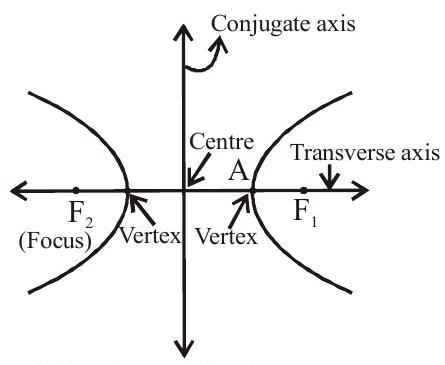
Two fixed points are known as Foci of the hyperbola.
The mid point of the line segment joining the foci is called the centre. The line joining the vertices is known as transverse axis and the line through the centre and perpendicular to transverse axis is known as conjugate axis. The point at which the hyperbola intersect the transverse axis is known as vertices of the hyperbola.
Definition 2 : The locus of a point which moves in a plane such that the ratio of its distance from a fixed point to its perpendicular distance from a fixed straight line (not passing through given fixed point) is always constant and greater than 1 .
The equation of hyperbola whose focus is the point
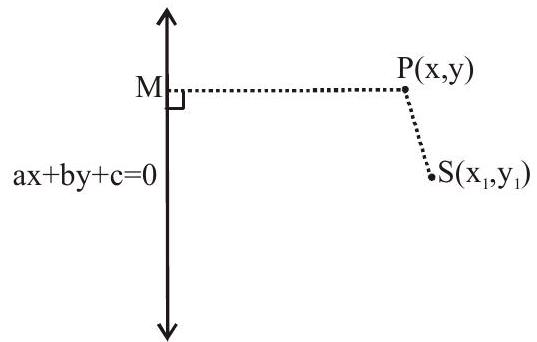
Eccentricity :
Some terms related to Hyperbola
Equation of hyperbola
1. Centre : All chords passing through a point and bisected at that point is known as centre of hyperbola.
2.Eccentricity :
3.Foci :
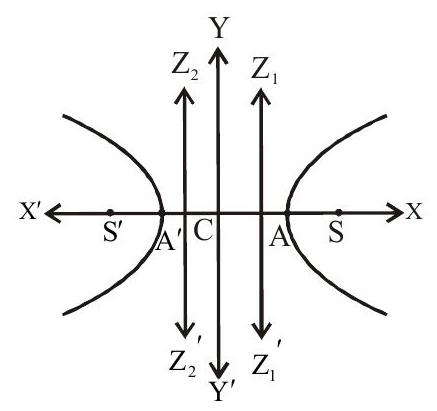
4.Directrices :
5.Vertices :
6.Axes : The line
Length of transverse axis
Length of conjugate axis
7.Double Ordinate : A chord of hyperbola which is perpendicular to transverse axis is known as double ordinate
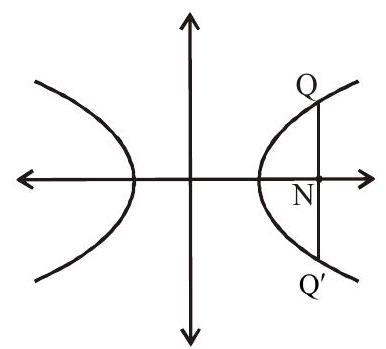
8.Latus rectum : The double ordinates passing through focus is known as latus rectum.
9.Focal chard : A chord passing through focus is known as focal chord.
10.Focal Distance :
Rectangular or Equilateral Hyperbola
If
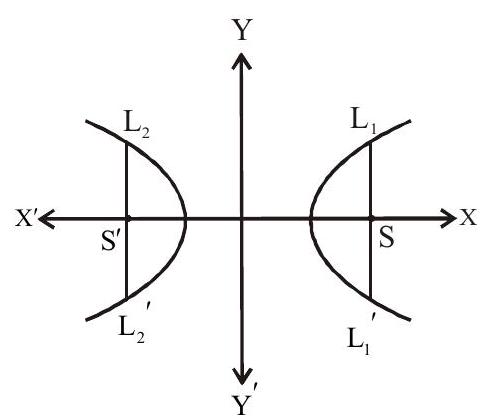
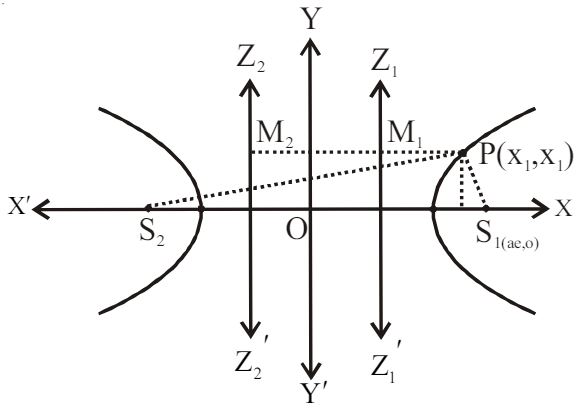
Equation of hyperbola if centre is (
Position of a point :
Let a point
If
If
If

Conjugate Hyperbola :
Corresponding to every hyperbola there exists a hyperbola such that the transverse axis and conjugate axis of one is equal to the conjugate axis and transverse axis of the other. Such hyperbolas are known as conjugate to each other.
Therefore for the hyperbola
Conjugate hyperbola is
Auxiliary circle and eccentric angle
A circle drawn with centre
A is any point on the circle whose coordinates are
| Hyperbola | Conjugate Hyperbola | |
|---|---|---|
| Equation | ||
| Centre | ||
| Vertice | ||
| Foci | ||
| Length of transverse axis | ||
| Length of conjugate axis | ||
| Length of latus rectum | ||
| Equation of transverse axis | ||
| Equation of conjugate axis | ||
| Equation of directrices | ||
| Eccentricity |
Equation of a Hyperbola referred to two perpendicular lines
Let equation of hyperbola be
From diagram
ie. if perpendicular distance of a point
then the locus of point
-
centre of the hyperbola, we get after solving
-
Transverse axis :
-
Conjugate axis
-
Foci : The foci of the hyperbola is the point of intersection of the lines
-
Directrix:
-
Length of transverse axis
-
Length of conjugate axis
-
Length of latus Rectum
Equation of tangent
(i) Point Form
Equation of tangent at point
(ii) Parametric Form :
Parametric equation of hyperbola is
Equation of tangent is
(iii) Slope Form :
Hyperbola
Point form :
Parametric Form :
Slope form:
Equation of Pair of Tangents
Let equation of hyperbola be
tangents
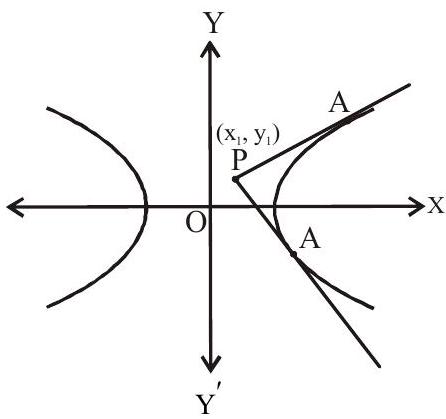
Equation of Normal to the Hyperbola :
i. Point Form
Slope to tangent
Slope to normal
Equation of normal
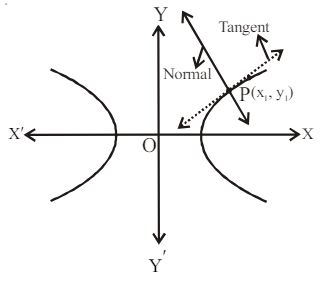
ii. Paramatric Form
or
iii. Slope Form
Point of contanct is
Equation of Chord of Contact
Let equation of hyperbola be
Equation of Chord of contact is
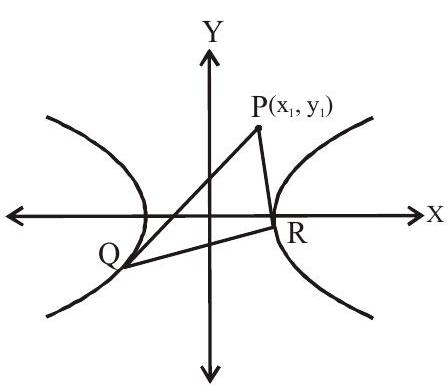
or
where
Equation of the chord of the hyperbola whose mid point is given :
ie.
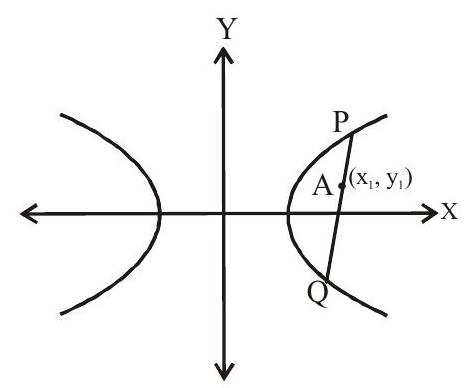
Asymptotes of Hyperbola
An asymptotes of any hyperbola is a straight line which touches in it two points at infinity.
OR
If the length of the perpendicular let fall from a point on a hyperbola to a straight line tends to zero as the point on the hyperbola moves to infinity along the hyperbola, then the straight line is called asymptote of the hyperbola.
The equation of two anymptotes of the hyparbola
are
Pair of asymptotoes :

1. If
2. A hyperbola and its conjugate hyperbola have the same asyptotes.
3. The angle between the asymptotes of
4. The asymptotes pass through the centre of the pyperbola.
5. The bisectors of the angle between the asymptotes are the coordinate axes.
6. Let
and
be the equation of the hyperbola, asymptotes and the conjugate hyperbola respectively, then clearly
Rectangular Hyperbola:
A hyperbola whose asymptotes include a right angle is said to be rectangular hyperbola.
OR
If the lengths of transverse and conjugate axes of any hyperbola be equal it is called rectangular or equilateral hyperbola.
Then asymptotes of
Now equation of asymptotes of new hyperbola is
Then equation of hyperbola is
The hyperbola passes through the point
Then equation of hyperbola is
If the asymptotes of a rectangular hyperbola are
1. Asymptotes :
2. Transverse axis:
Conjugate axis :
3. Vertices
4. Foci :
5. Length of transverse axis
6. Equation of auxiliary circle
7. Equation of director circle
8.
Properties of Rectangular Hyperbola
1. Eccentricity of rectangular hyperbola is
2. Since
3. Equation of chord joining
4. Equation of tangent at
5. Equation of tangent at is
6. Equation of normal at
Equation of normal at is
7. Point of intersection of tangents at
8. Point of intersection of normal at
Practice Problems
1. Equation of conjugate axis of hyperbola
(a)
(b)
(c)
(d) None of these
Show Answer
Solution:
Equation of asymptotes are
Hence their slaps are
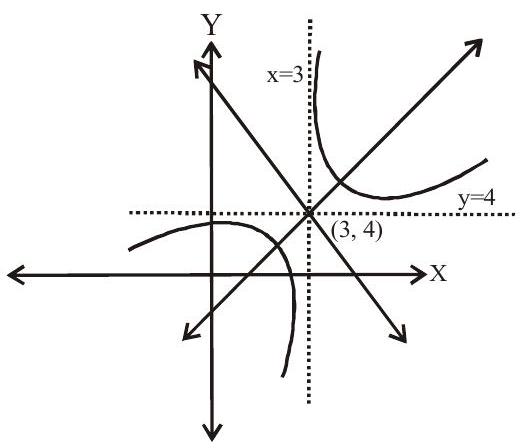
Answer (A)
2. If
(a) 156
(b) 36
(c) 26
(d) None of these
Show Answer
Solution:
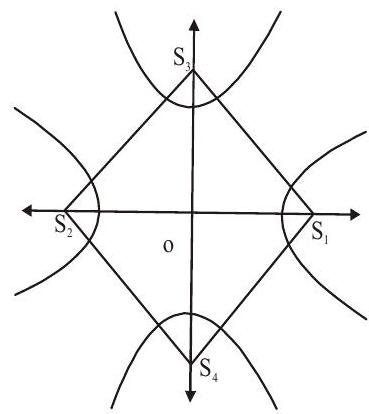
So required area
Now e
Hence area
Answer (C)
3. The ellipse
(a)
(b)
(c)
(d)
Show Answer
Solution:
Since ellipse and hyperbola intersect orthogonally, they are confocal.
foci of ellipse
Let point of intersection in the first quadrant be
Adding these two, we get
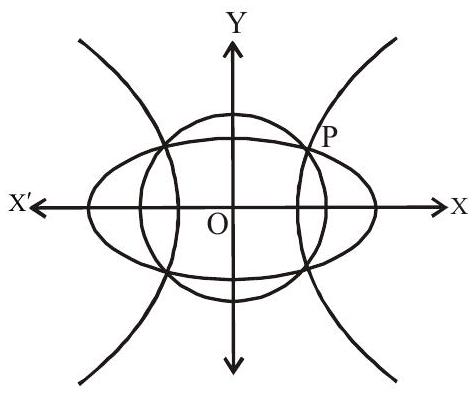
Equation of circle is
4. If
(a)
(b)
(c)
(d) None of these
Show Answer
Solution:
we know
Answer (a)
5. From a point
(a)
(b)
(c) 2
(d) None of these
Show Answer
Solution:
Equation of asymptotes are
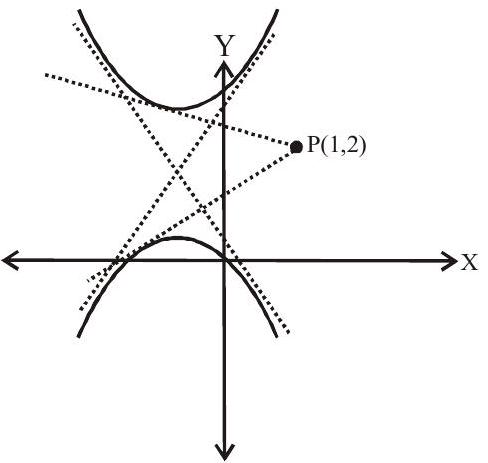
Answer b
6. If a variable line has its intercepts on the coordinate axes
(a) 4
(b) 3
(c) 2
(d) Can not be decided
Show Answer
Solution
Now
Line passing through the points
It is a tangent to the circle
Answer (c)
7. If angle between asymptotes of hyperbola
(a)
(b)
(c)
(d)
Show Answer
Solution
Required locus is director circle i.e.
If
Then equation of director circle is
Answer (a)
8. The equation of the transverse axis of the hyperbola
(a)
(b)
(c)
(d)
Show Answer
Solution
Directrix is
Equation of transverse axis is
Answer (c)
Exercise
1. The equation of common tangents to the parabola
(a)
(b)
(c)
(d)
Show Answer
Answer: c2. A tangent to the hyperbola
(a)
(b)
(c)
(d)
Show Answer
Answer: b3. The equation of the common tangent to the curves
(a)
(b)
(c)
(d)
Show Answer
Answer: a4. Let
(a)
(b)
(c)
(d) None of these
Show Answer
Answer: c5. The difference between the length 2a of the transverse axis of a hyperbola of eccentricity e and the length of its latus rectum is
(a)
(b)
(c)
(d)
Show Answer
Answer: d6. The slopes of common tangents to the hyperbolas
(a)
(b)
(c)
(d) None of these
Show Answer
Answer: c7. The two conics
(a)
(b)
(c)
(d)
Show Answer
Answer: a8. The point on the hyperbola
(a)
(b)
(c)
(d)
Show Answer
Answer: d9. If
(a)
(b)
(c)
(d) None of these
Show Answer
Answer: b10. If the latus rectum of a hyperbola through one focus subtends
(a)
(b)
(c)
(d)










